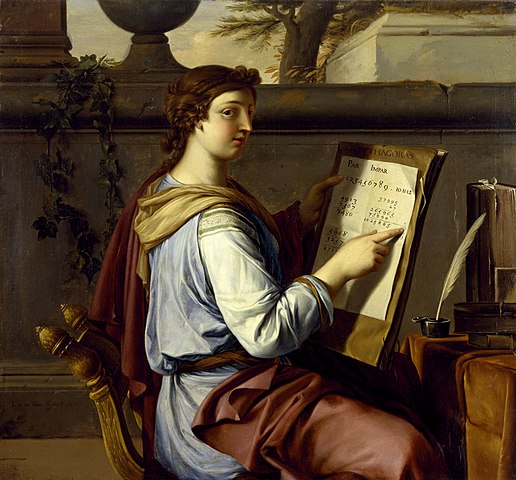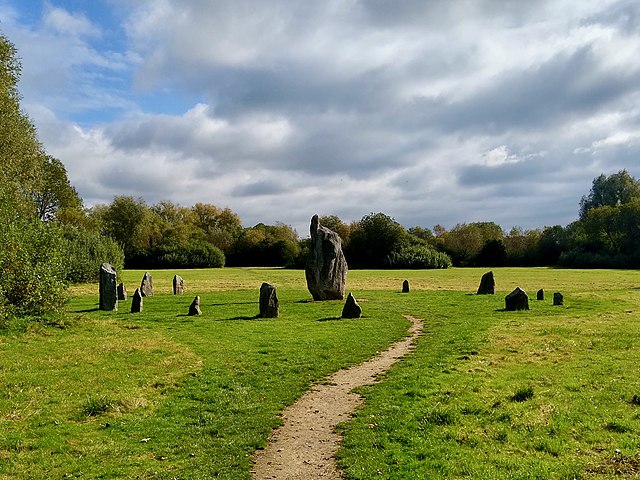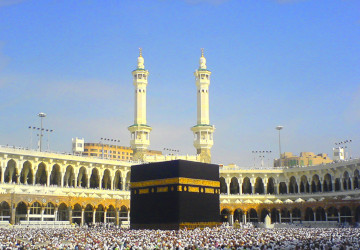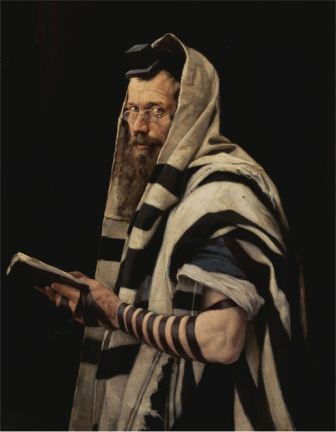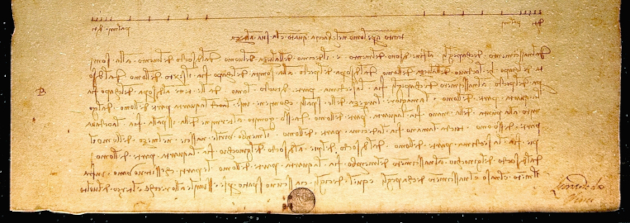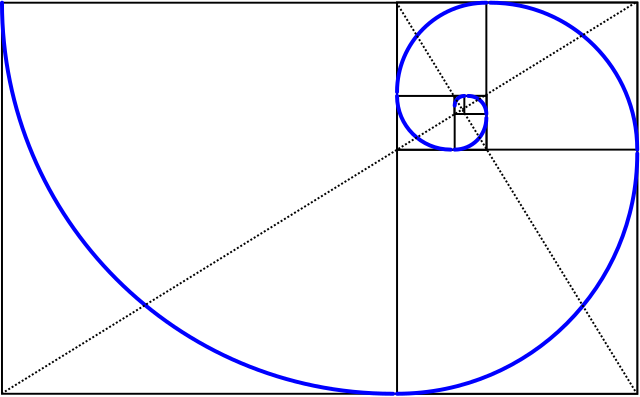Sacred Geometry
Sacred geometry delves into the exploration of geometric shapes and patterns, believed to carry profound spiritual or symbolic meanings. These shapes are often perceived as fundamental elements shaping the universe, woven into art, architecture, and religious symbolism across diverse cultures. This discipline's origins trace back to ancient civilizations' deep-seated fascination with the natural world, especially celestial occurrences.
Numerous ancient cultures like the Egyptians, Greeks, Chinese, and Maya meticulously studied celestial bodies, seeking insights into the universe's underlying structure and harmony. They meticulously observed recurring patterns in the sky, tracking planetary movements and crafting intricate calendars based on these celestial phenomena.
Such celestial observations profoundly influenced the emergence of geometric symbols and patterns within these civilizations. Some sacred geometric shapes were conceived as reflections or representations of celestial alignments or the dance of cosmic bodies. Remarkable ancient structures like Stonehenge in England or Egypt's pyramids are aligned with celestial events such as solstices and equinoxes. Certain geometric patterns were revered as depictions of cosmic principles or energies. The enigmatic Flower of Life, discovered in various ancient cultures, stands as a complex geometric figure symbolizing the interconnectedness permeating all life in the cosmos.
These geometric shapes often held mystical or spiritual interpretations. For example, the golden ratio, a mathematical proportion inherent in nature and art, was revered as a symbol of beauty and harmony. Its prevalence in natural phenomena and celestial proportions often evoked notions of divine design.
Through time, the study of celestial bodies and their intricate movements profoundly shaped the symbolism and interpretations within sacred geometry. The contemplation of celestial cycles, scrutiny of cosmic patterns, and the pursuit of understanding the universe's mysteries collectively contributed to the creation of geometric symbols and patterns infused with spiritual or cosmic significance. These intertwined pursuits shared a common goal - to comprehend the universe's enigmas and portray its order and beauty through diverse channels, whether through star observation or the creation of symbolic geometric forms.
Mathematics
When we talk about geometry, we also talk about mathematics. The science of mathematics is a vast field that explores patterns, structures, quantities, and relationships using logic and abstraction. It's a fundamental tool for understanding the world and solving problems across various disciplines.
It deals with the study of numbers and basic operations like addition, subtraction, multiplication, and division. Exploring shapes, sizes, properties, and dimensions of objects in space. It deals with rates of change and accumulation, crucial for understanding motion, growth, and many natural phenomena. Mathematics serves as a universal language that allows us to describe, analyze, and comprehend the patterns and structures that underlie the natural world and human endeavors. Its beauty lies in its precision, universality, and its ability to describe phenomena across diverse disciplines.
What we call math today is a mundane and secular shadow of what it meant to ancient Greeks or Egyptians or other civilizations. For that we must look at etymology of the word "mathematics".
Etymology of Mathematics
The term "mathematics" originates from the Ancient Greek word máthēma (μάθημα), which conveyed the concept of "that which is learned," encompassing the pursuit of knowledge, understanding, and awakening. In the time of Ancient Greeks like Pythagoras, mathematical exploration extended beyond basic arithmetic operations. Their focus involved unraveling the relationship between mathematics and the natural world - an exploration guided by nature, perceived as an endless source of wonder and profound teachings.
Within Pythagoreanism, one of the principal schools of thought was referred to as the mathēmatikoi (μαθηματικοί), denoting "learners" rather than the modern connotation of "mathematicians." In Latin and early English until approximately 1700, the term "mathematics" primarily signified "astrology" or sometimes "astronomy," diverging from its contemporary meaning. This shift in meaning gradually evolved between the 1500s and 1800s.
This evolution in terminology led to occasional misinterpretations. For instance, Saint Augustine's caution to Christians regarding the "mathematici" was not directed at mathematicians in the modern sense but rather aimed at practitioners of occult arts or astrology. Unfortunately, such references have occasionally been mistranslated, misinterpreting his words as condemnation toward mathematicians themselves.
"Let no one believe that the 'mathematici,' that is, astrologers, so speak and so act that they do not lie. It is one thing to know by experience; another, to suspect on uncertain grounds; another, to demonstrate by necessary reasons."
Archetypes
An archetype refers to a universally recognized symbol, pattern, or character that appears consistently across literature, art, mythology, or religious narratives. These symbols are ingrained, recurring elements that stir profound emotions or reactions. Archetypes embody fundamental human experiences, behaviors, or traits and span various cultures and eras.
When we take a moment to slow down and truly observe the world around us, amidst its incredible diversity, we notice repeated types or archetypes. There's an underlying order, guided by geometry. While no two instances of a pine cone, sunflower, spider web, or other elements are identical, they aren't merely chaotic randomness. Despite the multitude of variations we can perceive, our reasoning suggests an unseen, constant, somewhat mysterious pattern underlying each physical example. Plato termed these consistent patterns as forms.
Multiple products or physical manifestations might exist, but there's a singular form. When we grasp the symbolic or sacred geometry embedded in nature - the interwoven patterns, proportions, and numbers within plant and animal life - we begin to recognize how these same patterns and archetypes resonate within the things we create.
"If you find from your own experience that something is a fact and it contradicts what some authority has written down, then you must abandon the authority and base your reasoning on your own findings."
Leonardo da Vinci's quote underscores the significance of personal experience and direct observation over blindly adhering to established authority or teachings. He advocated for empirical knowledge and understanding natural principles based on firsthand findings rather than unquestioning acceptance of written authority.
The Great Architect
In ancient manuscripts and artworks, depictions of God often portray Him holding a compass and either measuring or drawing a circle. These representations are commonly referred to as "God the Geometer" or "God the Great Architect" by historians.
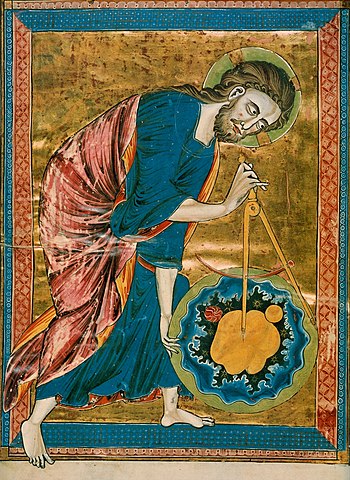
Platonist Creation according to Plutarch's Moralia 720c. God creates the Cosmos use a Compass with one arm on the precise Centre of the Cosmos and the other on the Periphery. The compass points to the fact that there is a relationship between the two. (source: Wikipedia)
The notion of "God the Great Architect" holds significance within certain philosophical and theological beliefs, notably within Freemasonry and specific esoteric traditions. Within Freemasonry, where symbolic teachings and rituals prevail, "God the Great Architect" embodies the divine creator of the universe. This portrayal emphasizes a supreme being who intricately designed and fashioned the cosmos. The term "Architect" is metaphorically employed to underscore the concept of purposeful design, intelligence, and harmony in the creation of the universe.
Compass and Square
The compass and square, practical tools with a legacy stretching across civilizations and centuries, were vital implements in construction and design. Stonemasons, architects, and builders relied on these tools for precision, creating arcs, circles, and right angles to ensure geometric accuracy in constructing grand edifices like cathedrals and temples.
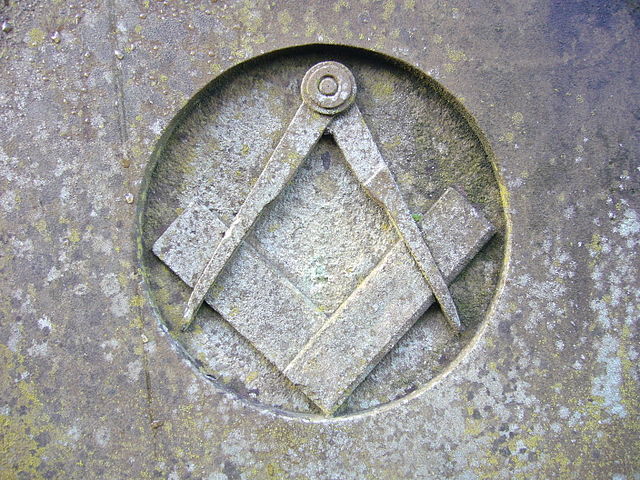
Square & compasses carved into stone. Part of the foundation stone on a masonic hall situated in the centre of Lancaster in the UK. (source: Wikipedia)
The compass, an instrument for drawing circles and arcs, holds a history reaching back millennia. Ancient cultures such as the Greeks, Egyptians, and Chinese crafted various versions for navigation, astronomy, and geometry. In geometry, the compass was indispensable for constructing precise shapes and circles.
Similarly, the square, ensuring right angles and straight lines, found roots in ancient civilizations. Egyptians and Mesopotamians used square-like tools for constructing buildings with exact angles. The Greek mathematician Euclid extensively explored the properties of squares and rectangles in his mathematical work.
As craftsmanship, mathematics, and engineering advanced, these tools evolved. During the Middle Ages and Renaissance, compasses and squares were foundational in erecting monumental structures.
Throughout history, Abrahamic religions perceived God as the Divine architect who laid the cosmic blueprint. This divine order signified the creator's presence in the universe. From the Abrahamic perspective to other traditions like Chinese mythology, deities portrayed as architects wielded these instruments, attributing distinct roles to each.
Beyond their historical significance, the compass and square hold esoteric importance. In Freemasonry, they symbolize moral teachings, termed the "working tools." The compass embodies spirituality, delineating moral boundaries and self-discipline, while the square represents earthly matters, symbolizing practicality, honesty, and integrity.
Medieval thinkers viewed the compass as a symbol of heavenly light and grace, guiding from above. Its point marks the center of a circle, a symbol of the infinite, perfect cosmos - a notion reflected in the Latin origin of "universe," meaning "combined into one, the totality of existing things."
"The Dao 道 gives birth to one. One gives birth to Two, Two gives birth to Three. Three gives birth to thousands of things or all things in the universe."
As Lao Tzu's "Tao Te Ching" suggests, nature's unity unfolds through geometry, emphasizing the interconnectedness and origin of the natural world. Geometry and beauty in nature serve as reminders of this unified origin.
Creation of Universe
Interested in uncovering the universe's beginnings? Join me on a journey through the cosmos' origins, exploring its fundamental elements - building blocks, geometric shapes, intricate patterns, and timeless archetypes. These entwined elements unveil the essence and enigmatic birth of our expansive universe.
"As legal residents of the cosmos we have the authority to view the world's blueprints. Here they are. Construct the patterns that construct the universe."
Number 1 - Monad
In the realm of mathematics, "one" stands as the fundamental and most basic natural number, typically denoted as "1". It serves as the elemental cornerstone from which all other numerical values emerge within arithmetic. As the identity element for multiplication and division, "one" lays the groundwork for numerical systems and acts as the foundational unit for counting.
Beyond its mathematical significance, "one" embodies concepts of unity, singularity, and indivisibility. This solitary digit represents uniqueness and exclusivity and holds philosophical and spiritual implications as a symbol of wholeness and the interconnectedness of all existence.
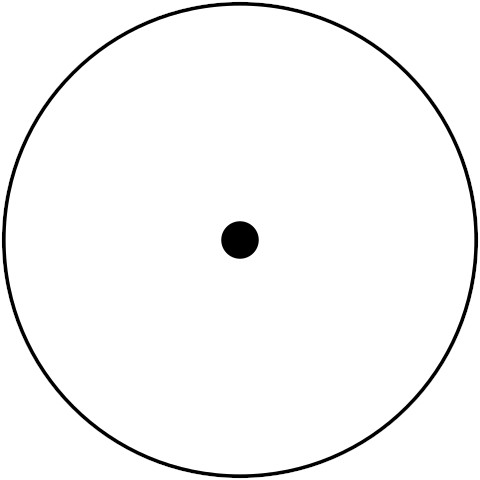
Monad from the Greek word monos or μονάς (from the word μόνος, which means "one", "single", or "unique"), was a symbol referred by the Greek philosophers as "The First", "The Seed", "The Essence", "The Builder", and "The Foundation." They also called it "Unity." Source: "Divine Proportion" by Priya Hemenway, page 51.
This singular digit encompasses a plethora of symbolic meanings, symbolizing the genesis, the commencement of a new journey, and the spark of initiation. Linked to traits like leadership, independence, and individual strength, "one" also holds cultural and divine symbolism, often representing the divine source or the ultimate deity from which everything emanates.
Furthermore, "one" embodies the idea of unity within diversity, highlighting the underlying interconnectedness among all entities despite their apparent differences. Symbolically, it's represented as a circle, mirroring the creation myths across various cultures that commence from an expansive divine center. This center signifies the nucleus around which existence revolves, akin to the core of an atom or the central star in a galaxy.
In geometry, the relationship between the radius and the circumference introduces the irrational number Pi (π): 3.14159... Its infinite, non-repeating decimal representation reflects the dual nature of creation - both boundless and confined simultaneously - a paradoxical concept that defines creativity's limitless yet finite essence.
Expanding from circles to the celestial realm, the North Star, also known as Polaris, holds a pivotal position almost directly above the Earth's North Pole. It seemingly remains fixed as the other stars orbit around it due to the Earth's rotation, symbolizing stability amidst motion.
In Vedic cosmology, the North Star, referred to as Dhruvaloka or Dhruva Nakshatra, embodies a celestial abode revered as the center of the celestial sphere. Associated with Lord Vishnu, this realm represents a higher plane beyond the material universe, signifying enlightenment, purity, and transcendence. The significance of this celestial realm is accentuated by the tale of Dhruva, a young prince who attained spiritual ascension, becoming the Pole Star in Hindu mythology.
Marcus Vitruvius Pollio's writings emphasize the necessity of diverse knowledge, including geometry, history, philosophy, music, medicine, astronomy, and architectural theory, underscoring the interconnectedness of various disciplines to comprehend the sundials and the heavens' workings.
"Let him be educated, skilful with the pencil, instructed in geometry, know much history, have followed the philosophers with attention, understand music, have some knowledge of medicine, know the opinions of the jurists, and be acquainted with astronomy and the theory of the heavens."
"From astronomy we find the east, west, south, and north, as well as the theory of the heavens, the equinox, solstice, and courses of the stars. If one has no knowledge of these matters, he will not be able to have any comprehension of the theory of sundials."
Number 2 - Dyad
In mathematics, 'two' stands as the primary and simplest even number, denoted as '2.' Following 'one' in the natural number sequence, it retains the distinction of being the only even prime number. It serves as a fundamental unit in basic arithmetic operations, pivotal in addition, subtraction, multiplication and division.
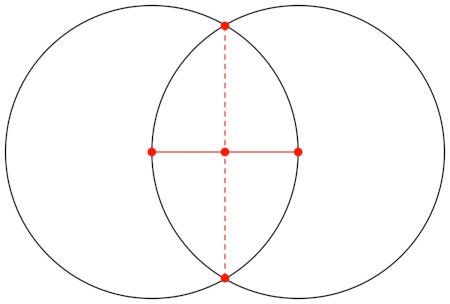
The word "dyad" originates from the Greek word "duas," meaning "two." In Greek philosophy, a "dyad" referred to a pair or a couple.
Symbolically, 'two' often embodies the concept of duality or pairs, representing opposition, balance, or complementarity. It signifies contrasting elements like light and dark, good and bad, or the yin and yang, reflecting the notion of opposing forces or complementary facets coalescing to create harmony or equilibrium. Moreover, 'two' frequently symbolizes division or the act of splitting a whole into halves. It stands as a representation of duality, balance, division, relationships, partnerships, or connections, emphasizing pairing, coupling, or the act of joining together.
This digit encapsulates conflict and harmony, symbolizing the resolution of opposites. When two circles overlap, they form the almond-shaped Vesica piscis or Mandorla, steeped in religious and symbolic history. In biology, mitosis illustrates the concept of a single cell duplicating to create a new cell, resulting in the vesica shape - the birth of something novel. Deriving its name from Latin meaning 'bladder of a fish,' the 'vesica piscis' mirrors the conjoined dual air bladders commonly found in fish. Christians embraced this shape, naming it mandorla ('almond'), adopting it as a symbol of Jesus as the mediator between God and humanity, representing the union of heaven and earth. Gothic architecture prominently features the vesica shape in rose windows found in cathedrals like Notre Dame de Paris and Chartres Cathedral. These intricate traceries, formed by intersecting circles, create the vesica shape at their centers. Many medieval churches exhibit vesica-shaped doorways or arches, known as Gothic arches today. These adorned royal portals at church entrances, symbolizing spiritual rebirth through Jesus upon entering the church.
Some ancient structures, such as Stonehenge in England, reveal alignments that create vesica-like shapes between stones during specific astronomical events. This iconic shape also graces decorative elements like mosaics, flooring patterns, and ornamental carvings in diverse architectural styles. Contemporary architects occasionally integrate vesica shapes into their designs, employing them in windows, doorways, or as design elements inspired by sacred geometry. The vesica piscis symbolizes harmony, unity, and profound spiritual significance across various cultures, recurring as a motif in architecture, especially in structures bearing religious or symbolic significance.
Vesica Piscis
The Vesica Piscis is a geometric shape formed by the intersection of two circles with the same radius, overlapping in such a way that the center of each circle lies on the circumference of the other. The resulting shape resembles an almond or a fish bladder, hence the name Vesica Piscis, which is Latin for "bladder of a fish." The Vesica Piscis serves as the basis for constructing other geometric forms, such as the equilateral triangle, square, pentagon, and hexagon, by using its intersecting circles as a foundational template.
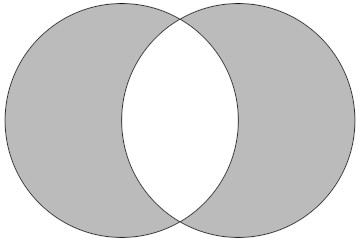
The vesica piscis is a symbol made from two circles of the same radius, intersecting in such a way that the center of each circle lies on the circumference of the other. The name literally means the bladder of the fish in Latin. In the Christian tradition, is is a reference to Christ, as in ichthys. It is called a mandorla ("almond") in italian and known in the early Mesopotamia African and Asian civilizations. (source: Wikipedia)
Symbolically, the Vesica Piscis holds significant meaning in various cultures, religions, and mystical traditions. Its geometric proportions are considered sacred and are believed to represent various spiritual concepts. The mystical and esoteric meanings attributed to the Vesica Piscis have led to its use in various spiritual practices, including sacred geometry, where it's believed to hold keys to understanding the structure of the cosmos and the nature of reality.
Historically, the Vesica Piscis has been used in art, architecture, and religious symbolism for centuries. In Christian iconography, it's associated with depictions of Christ and is often found in medieval art and architecture. The shape is also seen in the seals of various secret societies and esoteric traditions, where it carries symbolic significance related to the creation of the universe, divine unity, and the balance between opposites.
Symbolism of Vesica Piscis
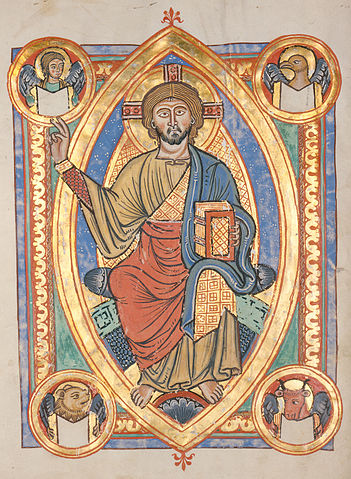
From manuscript in the Badische Landesbibliothek, Karlsruhe, Germany, Christ Pantocrator surrounded by symbols of the evangelists. (source: Wikipedia)
The shape is often seen as a symbol of creation or birth, representing the union of opposites or the coming together of two elements to create a new entity. This symbolism is often linked to the idea of fertility, regeneration, and the birth of the universe or new beginnings.
It symbolizes unity, harmony, and the interconnectedness of different forces or dimensions. The overlapping circles creating the Vesica Piscis are seen as representing the merging of spiritual and physical realms, the meeting of heaven and earth, or the integration of masculine and feminine energies.
In sacred geometry, the Vesica Piscis is considered a fundamental and powerful geometric form. It's believed to contain mathematical proportions and ratios that hold significance in understanding cosmic principles, underlying patterns in nature, and the structure of the universe.
In Christianity, the Vesica Piscis has been used to represent Christ and is found in religious art and symbolism associated with Jesus. The shape is used as a halo or aureole in depictions of Christ, symbolizing his divine nature and representing the intersection of the spiritual and earthly realms.
It signifies the balance between opposing forces, such as light and dark, yin and yang, or positive and negative energies. The shape's overlapping nature represents the coming together of polarities in a harmonious and balanced way.
Due to its resemblance to the female reproductive organ, the Vesica Piscis has been associated with feminine energy, fertility, and the divine feminine in various cultures and spiritual beliefs.
Number 3 - Triad
In the realm of mathematics, "three" marks the first odd prime number following "two," symbolized as "3." This numeric entity introduces multiplicative properties as the product of the initial two primes (2 × 3 = 6), serving as a foundational element in various mathematical concepts.

The word "triad" has its roots in ancient Greek. It is derived from the Greek word "triás," which means "group of three." In various contexts, "triad" refers to a set or group comprising three elements, individuals, or entities.
Symbolically, "three" embodies multifaceted meanings, often denoting balance, harmony, and entirety. It stands as a representation of unity while encapsulating the concept of a triad or trinity. Across diverse cultures and belief systems, the number "three" holds associations with completeness, resonating with tripartite principles like birth-life-death, beginning-middle-end, or body-mind-spirit.
In religious and spiritual contexts, "three" bears immense significance. Christianity venerates the Holy Trinity (Father, Son, and Holy Spirit) represented by the number three, while Hinduism features the Trimurti (Brahma, Vishnu, Shiva), embodying creation, preservation, and destruction. This numeric symbol similarly embodies divine attributes or triadic principles in various other belief systems.
"Three" permeates cultural narratives, myths, and proverbs, often linked to luck (as in "third time's a charm") or completeness (as in the "rule of three" in storytelling, lending greater satisfaction or memorability to grouped triads). Moreover, it is intrinsically tied to significant geometric shapes like the triangle, fundamental in various geometric constructions and tessellations.
The tension inherent in pairs is resolved with the introduction of the third element. This concept of mediation or synthesis is mirrored in philosophical reflections by Heraclitus and Aristotle, highlighting the virtue of finding balance through the 'mean.'
"What opposes unites, and the finest attunement stems from things bearing in opposite directions, and all things come about by strife."
"There are then three dispositions - two vices, one of excess and one of defect, and one virtue which is the observance of the mean; and each of them is in a certain way opposed to both the others. For the extreme states are the opposite both of the middle state and of each other, and the middle state is the opposite of both extremes;"
In the natural world, the manifestation of "three" is evident in the Lily's nine-petaled pattern or the arrangement of seeds in fruits and vegetables like melons, cucumbers, and clovers, echoing the geometry of triangles.
Historically, cartographers sometimes placed Jerusalem at the center of a three-petaled world map, highlighting its significance in Abrahamic religions. Even mountains, breaking the horizon, resemble symbolic triangles, like the Pyramids of Giza - a prominent example embodying the triangle's archetype.
Even in architecture, the strength and stability derived from triangles are evident in their structural forms. Even arches, seemingly unrelated to threes, showcase this concept beautifully. Leonardo da Vinci described an arch as two weaknesses combined to create strength.
"An arch consists of two weaknesses which, leaning one against the other, make a strength."
Triangles offer inherent stability, witnessed in engineering experiments and architectural designs like Borromini's Church of Sant'Ivo and Church of San Carlo al Quattro Fontane in Rome.
In essence, the number "three" carries a tapestry of symbolism and significance across diverse cultures and disciplines, symbolizing unity, completeness, harmony, and the triadic essence permeating various phenomena in the world.
Number 4 - Tetrad
In the realm of mathematics, "four" follows "three" as the initial composite number, symbolized as "4." As the square of the number two (2² = 4), it holds mathematical significance and is integral to basic arithmetic operations and numerical sequences.
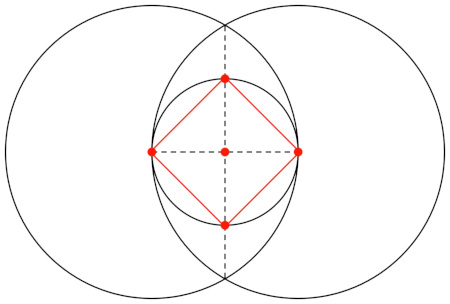
The word "tetrad" comes from the Greek word "tetras," which means "four." It's formed by combining the Greek prefix "tetra-" (meaning four) with the suffix "-ad" denoting a group or collection.
Symbolically, "four" is linked with stability, balance, and order, often associated with solidity and completeness due to its connection with square shapes and symmetry. The four sides of a square and the cardinal directions (north, south, east, west) resonate with the essence of the number "four." It transcends flat surfaces, allowing the creation of volumetric shapes, like the tetrahedron - a four-sided solid that introduces stability into the third dimension with minimal materials.
At the atomic level, a diamond's tetrahedral structure, formed by carbon atoms, signifies its exceptional strength and thermal conductivity, making it the hardest naturally occurring substance.
Ancient Greeks recognized the representation of balance and equality in the numeral four, drawn on a two by two grid, akin to a symbol of Justice.
The cultural, spiritual, and religious contexts of "four" are abundant. Numerous belief systems reference the four elements (earth, water, air, fire) or the cardinal directions, symbolizing the completeness and wholeness of the world. The division of Earth into four quadrants symbolizes strength and substance, extending to time's cyclic nature, delineating the year into four seasons.
Nature's efficient use of resources finds resonance in Johannes Kepler's quote, while Leonardo da Vinci's Vitruvian man, combining square and circular proportions, mirrors the symbolism in temples and classical architecture, where proportions reflected divinity and human forms.
"Nature uses as little as possible of anything."
Ancient philosophers associated the four elements with different facets of the soul. Cubes, linked with perfection, echoed in sacred spaces, embodying the concept of heavenly paradises. Temples, seen as connections between heaven and earth, symbolically represented the human body and the universe in Hindu beliefs, positioning deities at their center.
Architecture and design revere "four" for its stability and symmetry, often basing designs on quadrilateral shapes. Roman and Spanish Colonial city planning highlighted sacred city centers at major cross streets, a practice reflecting the balance and order associated with the number "four".
In essence, "four" symbolizes stability, completeness, balance, and order both mathematically and symbolically, resonating across cultural, philosophical, and architectural domains.
Cube
A cube is a three-dimensional geometric shape that has six square faces, where each face is identical in size and shape. All angles in a cube are right angles (90 degrees), and all edges have the same length. The cube is a type of prism and a regular hexahedron, possessing symmetry along its axes and having equal diagonals that intersect at right angles at the center of the cube.
The cube is seen as a symbol of the material realm, representing stability, structure, and the physical elements. It embodies the four directions or elements (earth, air, fire, water) depending on the tradition, serving as a foundation for manifestation. Within esoteric beliefs, geometric shapes like the cube are often viewed as embodying fundamental principles of creation and divine order. The cube, with its equal sides and angles, is considered a symbol of perfection and balance in the universe.
In sacred geometry, the cube holds significance as a symbol of stability, solidity, and the material world. It represents the element of Earth and is associated with grounding, balance, and structure. The cube is considered a fundamental shape in sacred geometry, often seen as a building block for more complex forms. It's perceived as a representation of the physical realm and is linked to concepts of manifestation, foundation, and the earthly aspects of existence.
Cube in esoteric cults and religious traditions
The cube, due to its geometric properties and symbolic significance, appears in various esoteric cults and religious traditions in different forms.
-
Kaaba in Islam
The Kaaba, located in Mecca, Saudi Arabia, is a cubic structure draped in black cloth. It's considered the most sacred site in Islam and serves as the focal point for prayers. While its origins predate Islam, the Kaaba is central to Islamic worship and pilgrimage (Hajj). Worshippers face the Kaaba during their prayers, symbolizing unity and the oneness of God.
-
Tefillin in Judaism
As mentioned earlier, one of the components of Tefillin, the shel rosh (head Tefillin), is constructed in the shape of a cube or cubic form. Tefillin are worn by observant Jewish men during morning prayers as a reminder of God's presence and the commandments.
-
Saturnian Symbolism
In esoteric traditions linked to Saturnian cults or mysticism, the cube is associated with the planet Saturn. Some belief systems consider Saturn a symbol of limitation, structure, and time. The cube might be used as a representation of these qualities in rituals or as a symbol of Saturn's influence.

Voyager 1 image of Saturn and its ring taken four days after closest approach to Saturn, from a distance of 5,300, 000 km (3,300,000 miles). (source: Wikipedia)
In astrological beliefs, Saturn represents discipline, responsibility, restriction, and the passage of time. These qualities are sometimes metaphorically connected to the cube's attributes of boundaries, rigidity, and containment.
Vitruvian Man
The Vitruvian Man is a famous drawing by Leonardo da Vinci that represents the ideal proportions of the human body. It is based on the writings of the ancient Roman architect Vitruvius, hence the name. Vitruvius described in his architectural treatise "De Architectura" the concept of ideal human proportions in relation to geometry and architecture.
Leonardo da Vinci's Vitruvian Man, created around 1490, is a depiction of a man with outstretched arms and legs inscribed in both a circle and a square. This drawing illustrates the correlations between the proportions of the human body and geometric shapes, embodying the idea of the "perfect" human form in harmony with both the circle (representing the divine) and the square (representing the earthly).
"In a temple there ought to be harmony in the symmetrical relations of the different parts to the whole. In the human body, the central point is the navel. If a man is placed flat on his back, with his hands and feet extended, and a compass centered at his navel, his fingers and toes will touch the circumference of a circle thereby described. And just as the human body yields a circular outline, so too a square may be found from it. For if we measure the distance from the soles of the feet to the top of the head, and then apply that measure to the outstretched arms, the breadth will be found to be the same as the height, as in the case of a perfect square."
Leonardo's illustration wasn't just an anatomical study; it was a synthesis of art, science, and philosophy. His fascination with anatomy and his desire to understand the human body's proportions and mechanics drove him to create this iconic drawing. Leonardo's work significantly contributed to the understanding of human anatomy and its relationship to both art and science.
The Vitruvian Man has become an iconic symbol, representing the intersection of art and science and the quest for understanding the human body's inherent beauty and proportion. It continues to be celebrated for its symbolism and as a representation of the harmonious relationship between humanity and the universe.
Name
Leonardo da Vinci's drawing is titled in his notes as "Le proporzioni del corpo umano secondo Vitruvio," which has been translated as "The Proportions of the Human Figure after Vitruvius" or "Proportional Study of a Man in the Manner of Vitruvius." However, it's more commonly known as the Vitruvian Man. Art historian Carlo Pedretti refers to it as "Homo Vitruvius," describing it as a study of proportions featuring a human figure inscribed within both a circle and a square. Later, it's simply referenced as "Homo Vitruvius."
Description and Composition
The drawing was meticulously crafted primarily using pen and light-brown ink, supplemented by hints of brown wash, giving it a subtle watercolor effect. Measuring 34.4 cm × 25.5 cm (13.5 in × 10.0 in), it surpasses the typical size of Leonardo's manuscript sheets, presenting an irregularly edged paper with a somewhat uneven original texture. Examination of the artwork unveils its precise preparation, devoid of any tentative or hasty lines. Leonardo employed metalpoint with calipers and compass, ensuring exactness in the drawn lines, while tiny tick marks served for measurements. Notably, the compass marks reveal a structured series of measured intervals, harmonizing with the geometric shapes forming the overall composition.
The Vitruvian Man illustrates a nude figure frontally positioned within both a square and a superimposed circle. It captures the man in a paradoxical fusion of poses: arms both raised above and perpendicular to his shoulders, legs positioned both together and spread along the base of the encircling shape. Carlo Vecce, a scholar, highlights this portrayal's dynamic essence, likening it to freezing multiple movement phases in a single image, akin to a photograph. The careful arrangement of the man's fingers and toes avoids breaching the surrounding shapes, a testament to Leonardo's deliberate artistry. Commentators frequently acknowledge Leonardo's intentional pursuit of an artistic rendition rather than a mere depiction. Biographer Walter Isaacson underlines the delicate lines, the captivating gaze, and intricate curls in the hair, weaving together elements of the human and divine. Additionally, Pedretti observes striking resemblances between this figure and the angel depicted in Leonardo's earlier painting, the Annunciation.
Text above
"Vetruvio, architecto, mecte nella sua op(er)a d'architectura, chelle misure dell'omo sono dalla natura disstribuite inquessto modo cioè che 4 diti fa 1 palmo, et 4 palmi fa 1 pie, 6 palmi fa un chubito, 4 cubiti fa 1 homo, he 4 chubiti fa 1 passo, he 24 palmi fa 1 homo ecqueste misure son ne' sua edifiti. Settu ap(r)i ta(n)to le ga(m)be chettu chali da chapo 1/14 di tua altez(z)a e ap(r)i e alza tanto le b(r)acia che cholle lunge dita tu tochi la linia della somita del chapo, sappi che 'l cie(n)tro delle stremita delle ap(er)te me(m)bra fia il bellicho. Ello spatio chessi truova infralle ga(m)be fia tria(n)golo equilatero."
Translation:
Vitruvius, the architect, says in his architectural work that the measurements of man are in nature distributed in this manner, that is 4 fingers make a palm, 4 palms make a foot, 6 palms make a cubit, 4 cubits make a man, 4 cubits make a footstep, 24 palms make a man and these measures are in his buildings. If you open your legs enough that your head is lowered by 1/14 of your height and raise your arms enough that your extended fingers touch the line of the top of your head, let you know that the center of the ends of the open limbs will be the navel, and the space between the legs will be an equilateral triangle.
Text below
"Tanto ap(r)e l'omo nele b(r)accia, qua(n)to ella sua alteza. Dal nasscimento de chapegli al fine di sotto del mento è il decimo dell'altez(z)a del(l)'uomo. Dal di socto del mento alla som(m)ità del chapo he l'octavo dell'altez(z)a dell'omo. Dal di sop(r)a del pecto alla som(m)ità del chapo fia il sexto dell'omo. Dal di sop(r)a del pecto al nasscime(n)to de chapegli fia la sectima parte di tucto l'omo. Dalle tette al di sop(r)a del chapo fia la quarta parte dell'omo. La mag(g)iore larg(h)ez(z)a delle spalli chontiene insè [la oct] la quarta parte dell'omo. Dal gomito alla punta della mano fia la quarta parte dell'omo, da esso gomito al termine della isspalla fia la octava parte d'esso omo; tucta la mano fia la decima parte dell'omo. Il menb(r)o birile nasscie nel mez(z)o dell'omo. Il piè fia la sectima parte dell'omo. Dal di socto del piè al di socto del ginochio fia la quarta parte dell'omo. Dal di socto del ginochio al nasscime(n)to del memb(r)o fia la quarta parte dell'omo. Le parti chessi truovano infra il me(n)to e 'l naso e 'l nasscime(n)to de chapegli e quel de cigli ciasscuno spatio p(er)se essimile alloreche è 'l terzo del volto."
Translation:
The length of the outspread arms is equal to the height of the man. From the hairline to the bottom of the chin is one-tenth of the height of the man. From below the chin to the top of the head is one-eighth of the height of the man. From above the chest to the top of the head is one-sixth of the height of the man. From above the chest to the hairline is one-seventh of the height of a man. From the chest to the head is a quarter of the height of the man. The maximum width of the shoulders contains a quarter of the man. From the elbow to the tip of the hand is a quarter of the height of a man; the distance from the elbow to the armpit is one-eighth of the height of the man; the length of the hand is one-tenth of the man. The virile member is at the half height of the man. The foot is one-seventh of the man. From below the foot to below the knee is a quarter of the man. From below the knee to the root of the member is a quarter of the man. The distances from the chin to the nose and the hairline and the eyebrows are equal to the ears and one-third of the face.
Legacy
The Vitruvian Man stands as a quintessential symbol of the High Renaissance, much like Leonardo himself embodies the epitome of a 'Renaissance man.' It holds a unique status by seamlessly integrating art, mathematics, science, classicism, and naturalism. According to art historian Ludwig Heinrich Heydenreich, Leonardo envisioned this masterpiece as a 'cosmography of the microcosm,' seeing the human body as a miniature reflection of the universe, a concept he explored through both his anatomical studies and the Vitruvian Man.
Renowned scholar Kemp dubs this drawing "the world's most famous," while Bambach regards it as an icon of Western civilization. However, Bambach also notes how its widespread commercialization in modern times, seen in popular books, advertising, and even on the Euro coin, has somewhat stripped it of its original Renaissance essence, making it challenging for viewers to grasp its nuanced, artistic brilliance.
Number 5 - Pentad
In mathematics, "five" stands as a prime number, symbolized as "5," positioned third in the prime number sequence and second within the Fibonacci series. Its significance extends as the sum of the initial two prime numbers (2 + 3 = 5), occupying a pivotal midpoint in arithmetic sequences.

The term "pentad" originates from the Greek word "pénte," which means "five." Similar to other numerical terms like "tetrad" (four) and "triad" (three), "pentad" follows the same pattern. It represents a group or set of five elements, individuals, or entities.
Symbolically, "five" embodies balance, harmony, and transformative change, representing a dynamic equilibrium between odd (unbalanced) and even (balanced) numbers. This balance resonates in examples such as the five fingers, five senses, and five elements (earth, water, fire, air, and ether/spirit), symbolizing completeness.
Diverse cultural and belief systems attribute significance to the number "five." Hinduism embraces the five elements and senses, while Buddhism associates the Dhyani Buddhas with specific directions and elements, representing aspects of enlightenment.
Geometrically, "five" is synonymous with the pentagon, exhibiting five sides and angles. This shape, present in nature's formations and man-made designs, symbolizes natural harmony and aesthetic allure.
Representing the junction between stability and change, "five" signifies transformation, growth, and the cyclic nature of life and the cosmos.
Evident in natural phenomena like the arrangement of apple seeds forming a five-pointed star and Venus's celestial pattern every 8 Earth years or 13 Venus years, the number "five" intertwines with the Fibonacci sequence, showcasing the intrinsic growth of numbers culminating in the golden ratio, Phi (around 1.61803).
From music's Fibonacci - inspired structure to the architectural symbolism of the pentagram in Christian buildings, "five" permeates diverse disciplines, manifesting in compositions, harmonies, and structural designs.
The golden spiral, omnipresent in nature, human proportions, and architectural orders, reflects the influence of the number "five". The four-to-one ratio is inherent in all five of the classical orders: Tuscan, Doric, Ionic, Corinthian, and composite. This ratio of four to one defines these orders, totaling five parts altogether. Classical traditions depict this ratio through measurements like the Cubit, integrating symbolism into proportions. An ideal man's height was considered four cubits. By raising hands above the head in prayer, adding one cubit, this creates a representation of five cubits, four for the body's height and the fifth for the entablature, symbolizing the Heavenly Realm.
Altogether, "five" symbolizes balance, change, and completeness, resonating across mathematical, cultural, and philosophical spheres, embodying notions of harmony and equilibrium.
Fibonacci sequence
The Fibonacci sequence is a series of numbers in which each number (after the first two numbers, typically 0 and 1) is the sum of the two preceding ones. Mathematically, it can be defined by the recurrence relation:
F(n) = F(n-1) + F(n-2)
Here, F(n) represents the nth term in the sequence, and F(n-1) and F(n-2) represent the preceding two terms.
The sequence typically starts with 0 and 1, so the first few terms are usually 0, 1, 1, 2, 3, 5, 8, 13, 21, and so on. The sequence continues infinitely, with each subsequent number being the sum of the two numbers that precede it.
The sequence has fascinating mathematical properties and appears in various natural phenomena, from the arrangement of leaves on a stem, the pattern of seeds in a sunflower, to the branching of trees. Additionally, it has applications in various fields, including mathematics, computer science, art, and nature studies. The ratio of consecutive numbers in the Fibonacci sequence, as the numbers get larger, approaches the "Golden Ratio" or phi (φ ≈ 1.6180339887), a ratio found in art, architecture, and nature, often considered aesthetically pleasing. Its beauty lies not only in its mathematical properties but also in its occurrence in the natural world, making it a fascinating subject for exploration and study across different disciplines.
History of Fibonacci sequence
The Fibonacci sequence is named after Leonardo of Pisa, also known as Fibonacci, an Italian mathematician born around 1170 AD. He introduced this sequence to the Western world in his book "Liber Abaci" (The Book of Calculation), published in 1202.
While Fibonacci didn't discover the sequence himself, he encountered it while studying the reproduction of rabbits. He posed a problem that assumed a pair of rabbits, starting from birth, would produce another pair in the second month, and subsequently, each pair would reproduce from the second month onward. This hypothetical scenario led to the creation of the sequence, where each number represented the total number of pairs of rabbits in each month.
In "Liber Abaci," Fibonacci used this sequence as an example to illustrate various mathematical concepts, including arithmetic and geometric progressions. His book aimed to promote the Hindu-Arabic numeral system (0-9) over the Roman numeral system and demonstrated its efficacy in commercial and mathematical calculations.
Initially, Fibonacci's work wasn't widely embraced in Europe. However, over time, "Liber Abaci" gained attention and contributed significantly to the dissemination of the numeral system and mathematical concepts. The Fibonacci sequence, initially introduced as an example in a problem, gradually gained recognition for its mathematical properties.
The sequence's intriguing properties, such as its recurrence relation and the appearance of the golden ratio in its ratios, made it a subject of interest among mathematicians. Over centuries, the sequence's presence in various natural phenomena, from the arrangement of leaves on plants to the patterns in flower petals, further fueled its exploration across different fields, including mathematics, art, architecture, and biology.
The presence of the Fibonacci sequence in Indian mathematics is evident in its connection to Sanskrit prosody. Within the Sanskrit poetic tradition, there was a keen interest in enumerating various patterns of long (L) syllables lasting for 2 units juxtaposed with short (S) syllables of 1 unit. This exploration of different patterns in successive L and S syllables, totaling a specific duration, directly corresponds to the Fibonacci numbers: the count of patterns for a duration of m units corresponds to Fm+1.
The understanding of the Fibonacci sequence traces back to Pingala (circa 450 BC–200 BC). Scholars interpret Pingala's enigmatic expression "misrau cha" as signifying the mixing of two elements, and within this context, assert that the count of patterns for m beats (Fm+1) is derived by adding one [S] to the Fm cases and one [L] to the Fm−1 cases.
Additionally, Bharata Muni references knowledge of the sequence in the Natya Shastra (circa 100 BC–circa 350 AD). However, the most explicit elucidation of the sequence emerges in the writings of Virahanka (circa 700 AD), though his original work is lost, as referenced in a quotation by Gopala (circa 1135):
"Variations of two earlier meters [is the variation]... For example, for [a meter of length] four, variations of meters of two [and] three being mixed, five happens. [works out examples 8, 13, 21]... In this way, the process should be followed in all mātrā-vṛttas [prosodic combinations]."
Hemachandra (circa 1150) is also recognized for his understanding of the sequence, noting that "the sum of the last and the one before the last is the number ... of the next mātrā-vṛtta."
Today, the Fibonacci sequence remains a fundamental concept in mathematics and various disciplines, carrying forward Fibonacci's legacy from medieval Europe to contemporary studies and applications.
Fibonacci sequence in Nature
The Fibonacci sequence appears abundantly in nature, manifesting in various biological and natural phenomena. Some notable occurrences include:
-
Phyllotaxis
The arrangement of leaves, petals, seeds, and branches often follows the Fibonacci sequence. For instance, in sunflowers, the seeds spiral in opposing directions in successive Fibonacci numbers.
-
Pinecones and pineapples
The spirals visible in these structures often adhere to Fibonacci numbers, with the number of spirals running clockwise and counterclockwise being consecutive Fibonacci numbers.
-
Flower petals and plant growth
The number of petals in flowers frequently matches Fibonacci numbers: lilies with three petals, buttercups with five, delphiniums with eight, and so on. Similarly, the growth of many plants follows Fibonacci patterns in the arrangement of leaves around stems.
-
Shell shapes
Shells of certain mollusks, such as nautilus shells, exhibit spiral patterns akin to the Fibonacci sequence. The growth of these shells follows logarithmic spirals characterized by Fibonacci numbers.
-
Animal bodies
Some animal body proportions align with the Fibonacci sequence. For instance, the ratio of segments in the limbs of some mammals, the arrangement of scales in pineapples, and even the growth patterns of certain animal horns may follow Fibonacci numbers.
The presence of the Fibonacci sequence in nature is not due to a strict adherence to mathematical rules but arises from the efficiency of certain growth patterns and arrangements. These patterns often optimize space, resource distribution, and structural stability, leading to their prevalence in diverse forms of life and natural structures.
Fibonacci sequence in Architecture
The Fibonacci sequence and its related mathematical principles, such as the golden ratio, have had a significant impact on architecture throughout history. Architects have often used these mathematical concepts as guiding principles in designing structures, aiming to achieve aesthetically pleasing and harmonious designs. Here are some examples of Fibonacci sequence in architecture:
-
Proportional harmony
The golden ratio, derived from the Fibonacci sequence, is believed to represent aesthetically pleasing proportions. Architects have applied this ratio to building designs, using it to determine proportions for elements like building heights, widths, and openings (doors, windows). Structures that embody these ratios are thought to have a sense of visual balance and harmony.
-
Spiral forms and curves
The Fibonacci sequence is associated with the logarithmic spiral, also known as the "Fibonacci spiral." Architects sometimes incorporate this spiral form into their designs, seen in staircases, towers, and other architectural elements. For instance, spiral staircases may follow a form similar to the Fibonacci spiral, creating visually appealing and functional designs.
-
Structural patterns
The sequence's recursive nature inspires patterns found in architectural elements like the arrangement of leaves in plants or the branching of trees. Architects might use these patterns to guide the layout of columns, the distribution of elements, or even the design of façades, creating visually interesting and organic structures.
-
Historical buildings
Some historical structures, such as the Parthenon in Greece or the pyramids in Egypt, are believed to have proportions influenced by the golden ratio or Fibonacci sequence. While there's debate among scholars about the extent of intentional use, these buildings often display proportions that align with these mathematical principles.
-
Modern design
Contemporary architects continue to draw inspiration from the Fibonacci sequence and the golden ratio. While not always explicitly adhering to specific mathematical formulas, they often use these principles as guidelines to create buildings with balanced proportions, graceful curves, and visually pleasing layouts.
The Fibonacci sequence and its related mathematical concepts serve as a guiding aesthetic principle in architecture, providing architects with tools to create structures that aim for visual harmony, proportion, and a sense of natural beauty.
Fibonacci sequence in Art
The Fibonacci sequence and its related golden ratio have influenced art for centuries. Artists and architects have been inspired by the sequence's numerical properties and its association with natural forms, leading to its integration into various art forms and designs. Here are some examples of Fibonacci sequence in art:
-
Proportional aesthetics
The golden ratio (approximately 1.618) derived from the Fibonacci sequence is believed to represent aesthetically pleasing proportions. Artists, especially during the Renaissance, used this ratio to create compositions that were visually harmonious. Paintings, sculptures, and architectural designs often incorporated these proportions to create balance and beauty.
-
Spiral patterns
The Fibonacci sequence is closely associated with the logarithmic spiral, known as the "Fibonacci spiral." This spiral approximates the golden spiral, appearing in seashells, galaxies, hurricanes, and flower petals. Artists have utilized this spiral in their works to evoke natural beauty and harmony.
-
Composition and design
In visual arts, such as painting and photography, artists sometimes use the Fibonacci sequence to guide composition. Dividing canvases or frames into sections based on Fibonacci numbers can create visually appealing layouts and emphasize focal points within the artwork.
-
Fractal art
The recursive nature of the Fibonacci sequence lends itself to fractal art, where complex and intricate patterns are created through repeated mathematical processes. Artists create stunning digital or traditional artworks by employing fractal algorithms that generate intricate patterns reminiscent of natural forms.
The influence of the Fibonacci sequence in art is not limited to specific forms but is rather an underlying principle that has guided artists in creating compositions that resonate with a sense of harmony, balance, and natural beauty. Whether explicitly applied or subtly integrated, the sequence's mathematical elegance continues to inspire creativity across various artistic disciplines.
Spiral
The concept of a spiral is fundamental in mathematics, art, nature, and various sciences. A spiral is a curve that starts from a central point and expands outwardly in a continuously widening (or narrowing) circular pattern. It is characterized by a constant distance between successive turns. Spirals can be found in numerous natural phenomena, such as galaxies, seashells, hurricanes, and the structure of DNA.
The history of spirals traces back thousands of years. Ancient civilizations, like the Greeks and Egyptians, recognized the significance of spirals. They observed spirals in nature and incorporated them into their art and architecture. The Greeks, for instance, utilized the Golden Ratio - a mathematical proportion often represented by a logarithmic spiral - when designing buildings and sculptures to achieve aesthetically pleasing proportions.
Spirals have also been prominent in mathematics. The study of spirals led to the development of different types, such as the Archimedean spiral, logarithmic spiral, and the Fibonacci spiral. Archimedes, the Greek mathematician, described the Archimedean spiral in the 3rd century BC while studying the relationship between its radius and the angle of rotation. The logarithmic spiral, associated with growth patterns found in nature, gained attention through the works of mathematicians like Descartes and Bernoulli. The Fibonacci spiral, based on the Fibonacci sequence (0, 1, 1, 2, 3, 5, 8...), is a type of logarithmic spiral whose curve is created using squares based on Fibonacci numbers.
The significance of spirals expanded into various fields, including physics, biology, and architecture. In physics, spirals are observed in waveforms, electromagnetic fields, and the patterns of celestial bodies. Biologically, they're found in the growth patterns of plants, shells, in arrangement of seeds in sunflowers, and even in the structure of DNA. Architects and designers often draw inspiration from spirals for their aesthetic appeal and functional aspects, utilizing them in structures like staircases and buildings to optimize space and create visually stunning designs.
Archimedean spiral
The concept of a spiral is fundamental in mathematics, art, nature, and various sciences. A spiral is a curve that starts from a central point and expands outwardly in a continuously widening (or narrowing) circular pattern. It is characterized by a constant distance between successive turns. Spirals can be found in numerous natural phenomena, such as galaxies, seashells, hurricanes, and the structure of DNA.
The history of spirals traces back thousands of years. Ancient civilizations, like the Greeks and Egyptians, recognized the significance of spirals. They observed spirals in nature and incorporated them into their art and architecture. The Greeks, for instance, utilized the Golden Ratio - a mathematical proportion often represented by a logarithmic spiral - when designing buildings and sculptures to achieve aesthetically pleasing proportions.
Spirals have also been prominent in mathematics. The study of spirals led to the development of different types, such as the Archimedean spiral, logarithmic spiral, and the Fibonacci spiral. Archimedes, the Greek mathematician, described the Archimedean spiral in the 3rd century BC while studying the relationship between its radius and the angle of rotation. The logarithmic spiral, associated with growth patterns found in nature, gained attention through the works of mathematicians like Descartes and Bernoulli. The Fibonacci spiral, based on the Fibonacci sequence (0, 1, 1, 2, 3, 5, 8...), is a type of logarithmic spiral whose curve is created using squares based on Fibonacci numbers.
The significance of spirals expanded into various fields, including physics, biology, and architecture. In physics, spirals are observed in waveforms, electromagnetic fields, and the patterns of celestial bodies. Biologically, they're found in the growth patterns of plants, shells, in arrangement of seeds in sunflowers, and even in the structure of DNA. Architects and designers often draw inspiration from spirals for their aesthetic appeal and functional aspects, utilizing them in structures like staircases and buildings to optimize space and create visually stunning designs.
Golden spiral
The Golden Spiral, also known as the Fibonacci Spiral, is a geometric figure that emerges from the Fibonacci sequence, a series of numbers where each number is the sum of the two preceding ones (0, 1, 1, 2, 3, 5, 8, 13, and so on). This sequence produces what's known as the Golden Ratio, approximately equal to 1.618.
The Golden Spiral is derived from the Golden Ratio through a specific geometric construction. Starting with a square, you draw smaller squares whose side lengths are defined by the Fibonacci sequence. Then, you draw quarter circles inside each of these squares, which create a spiral that appears to expand infinitely while maintaining the proportions of the Golden Ratio.
This spiral is found abundantly in nature, from the arrangement of leaves on plants to the spiral arms of galaxies. Its aesthetic appeal and prevalence in the natural world have fascinated mathematicians, scientists, and artists for centuries.
The concept of the Golden Ratio and its associated spiral has a historical lineage that dates back to ancient civilizations like the Greeks, who admired its aesthetic harmony. It gained prominence during the Renaissance, where artists and architects like Leonardo da Vinci and Le Corbusier employed its proportions in their work. Moreover, mathematicians such as Fibonacci introduced this sequence to the Western world in the 13th century through his book "Liber Abaci."
Throughout history, the Golden Spiral has been associated with beauty, balance, and harmony. Its appearance in both natural forms and human-made structures has fueled ongoing research and exploration into its mathematical properties and its role in art, design, and the sciences.
Golden spiral in Art
The Golden Spiral, derived from the Golden Ratio, has been a source of inspiration for artists across different periods and cultures. It's been utilized as a compositional tool to create aesthetically pleasing and harmonious works of art. Artists often incorporate the proportions of the Golden Spiral knowingly or intuitively to achieve balance, rhythm, and visual appeal in their creations.
Artists during the Renaissance, like Leonardo da Vinci and Michelangelo, were known to employ the Golden Ratio and its associated spiral in their compositions. For instance, da Vinci's "Vitruvian Man" is often cited as an example where the proportions of the human body correspond to the Golden Ratio.
Architects have used the Golden Ratio and its spiral in designing structures to create visually pleasing proportions. The Parthenon in Greece and the Notre Dame Cathedral in France are examples often cited for their adherence to these principles.
Artists in the 20th century, such as Piet Mondrian and Salvador Dalí, incorporated the Golden Ratio and its spiral in their works. Mondrian's abstract compositions often had elements following these proportions, while Dalí explored the spiral in his painting "The Sacrament of the Last Supper."
The Golden Spiral is also used in photography and design as a guideline for composition. Photographers often use it to create visually striking images, and designers employ it in layouts to guide the viewer's eye through the design elements.
Golden spiral in Nature
The presence of the Golden Spiral in nature is pervasive and intriguing. It manifests in various forms, showcasing the inherent mathematical beauty of the Fibonacci sequence and the Golden Ratio.
The shells of certain mollusks, such as the nautilus, often exhibit a spiral form that approximates the Golden Spiral. As these creatures grow, they create new chambers in a logarithmic spiral pattern, following the proportions of the Golden Ratio.
The arrangement of petals in some flowers follows the Fibonacci sequence, leading to a spiral pattern. Sunflowers, for example, have spirals of seeds that follow Fibonacci numbers, forming distinctive patterns.
The arrangement of scales on pinecones and pineapples or the segments on pineapples often adheres to Fibonacci numbers, resulting in spiral patterns.
The arms of spiral galaxies, such as the Milky Way, often exhibit a pattern that approximates the Golden Spiral. The distribution of stars and the structure of these galaxies often follows a logarithmic spiral.
Some weather patterns, like hurricanes, exhibit a spiral structure reminiscent of the Golden Spiral. While not a direct manifestation of the Fibonacci sequence, these patterns often display similar geometric characteristics.
These occurrences in nature showcase the prevalence of mathematical principles like the Golden Ratio and the Fibonacci sequence. They suggest that these mathematical relationships contribute to the structural formations observed in various natural phenomena, highlighting a fascinating connection between mathematics and the physical world.
Number 6 - Hexad
In the realm of mathematics, "six" stands as an even number, represented by "6." It holds the distinction of being the smallest perfect number, as it equals the sum of its divisors (1, 2, 3), excluding itself (1 + 2 + 3 = 6). Additionally, it's the product of the initial two prime numbers (2 × 3 = 6).
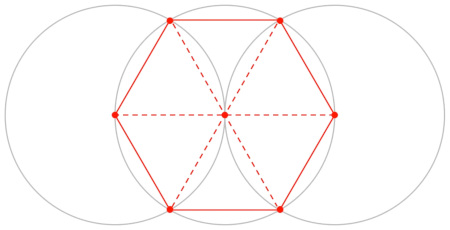
The term "hexad" traces its origins to the ancient Greek word "hex," meaning "six." By adding the suffix "-ad," commonly used to denote a grouping or collection, the term "hexad" was formed. It signifies a group or set of six elements, entities, or individuals.
Symbolically, "six" through its multiple divisors, embodies harmony, balance, and equilibrium, often linked with notions of symmetry and stability. Its divisibility by both two and three - representing duality and trinity, respectively - underscores its association with balance and stability.
Culturally and religiously, "six" holds various significances. Many belief systems associate six days with the creation of the world or cosmos. Christianity's creation story involves six days of creation, followed by a day of rest. Similarly, Hinduism recognizes six seasons within a year.
The hexagon, characterized by six sides and angles, aligns with the essence of "six." This shape, prevalent in nature within honeycombs, snowflakes, and certain crystals, symbolizes efficiency and structural stability.
The ancient Egyptian adage 'As Above So Below' correlates six with the hexad, evident in natural elements such as snowflakes, honeycombs, and floral structures. Roman architecture and Armenian designs prominently feature six-pointed stars and hexagons in various decorative elements and sacred structures.
The symbol of the Seal of Solomon or Star of David, a six-pointed star, holds significance in multiple faiths, including Judaism, Christianity, and Islam. Its presence extends from religious artifacts to national flags, symbolizing spiritual connections across cultures.
Examining the hexagon unveils its connection to three through its equilateral triangles, evident in architectural marvels like the Forbidden City in Beijing.
Overall, "six" epitomizes balance, harmony, and stability, resonating across mathematical, cultural, and spiritual domains, embodying completeness and structural order.
Flower of Life
The Flower of Life is a complex geometric pattern consisting of multiple evenly-spaced, overlapping circles arranged in a symmetrical flower-like shape. It's composed of multiple evenly spaced, overlapping circles that form a flower-like pattern with a hexagonal structure at its core. This pattern is characterized by its intricate and interconnected nature.
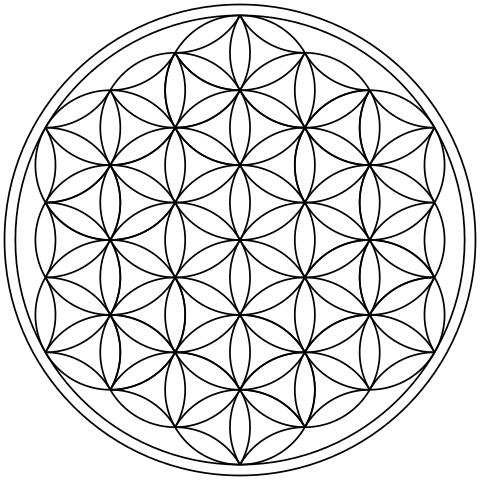
Most common form of the "Flower of Life" hexagonal pattern (where the center of each circle is on the circumference of six surrounding circles of the same diameter), made up of 19 complete circles and 36 partial circular arcs, enclosed by a large circle. (source: Wikipedia)
The Flower of Life symbolizes unity, harmony, and the interconnectedness of all life. It's often considered a symbol of creation and the fundamental structure of the universe. Within this symbol, many other geometric shapes and symbols, such as the Seed of Life and Metatron's Cube, can be found, each holding its own significance and symbolism.
The exact origins of the Flower of Life are difficult to pinpoint, but it has been found in various ancient cultures and civilizations worldwide. It has been discovered in temples, art, and manuscripts across different continents, including ancient Egypt, China, India, and throughout Europe.
One of the earliest known occurrences of the Flower of Life is in the Temple of Osiris in Abydos, Egypt, where it is engraved on a granite slab dating back thousands of years. It's also believed to be connected to sacred geometry and mystical teachings in various cultures, often associated with spiritual beliefs and cosmology.
In modern times, the Flower of Life gained significant attention due to its inclusion in New Age spirituality, sacred geometry studies, and alternative healing practices. It has become a symbol associated with spiritual growth, consciousness expansion, and the interconnectedness of all living things.
The development of its significance and interpretation has evolved through various esoteric teachings, spiritual practices, and studies of geometry. Today, it continues to inspire artists, philosophers, mathematicians, and those interested in spirituality and ancient wisdom.
The Flower of Life symbol has been discovered in various historical sites and artifacts around the world, often etched into ancient structures, sacred spaces, or depicted in art. Here are some notable sites where the symbol has been found:
-
Temple of Osiris, Abydos, Egypt
One of the earliest known occurrences of the Flower of Life can be found in the Temple of Osiris at Abydos, Egypt. It's engraved on a granite slab and dates back thousands of years.
-
Hypogeum of Ħal-Saflieni, Malta
The Flower of Life symbol has been found inscribed on a stone wall within this Neolithic subterranean structure, indicating its ancient origins.
-
Osaka Castle, Japan
The symbol has been discovered carved into the stone walls of Osaka Castle in Japan, indicating its presence in various cultures around the world.
-
Rosslyn Chapel, Scotland
Some researchers claim to have found representations of the Flower of Life within the intricate carvings and stonework of Rosslyn Chapel, a famous historical site.
Instances of the Flower of Life have been reported in numerous ancient sites, including temples in India, China, and throughout Europe, although some of these findings remain debated or speculative. The symbol's widespread occurrence across different civilizations hints at its universal significance and enduring symbolism throughout history.
Metatron's Cube
The Metatron's Cube is a geometric figure composed of multiple evenly-sized and interconnected circles. It's formed by lines that connect the center of each circle to the center of every other circle, creating a symmetrical pattern within a larger circle. This results in a three-dimensional shape known as a cube when viewed from a certain perspective.
Metatron's Cube is a powerful and complex sacred geometric symbol. It is associated with spiritual significance and is often considered a representation of the interconnectedness of the universe, containing within it the five Platonic solids - a set of geometric forms: tetrahedron, cube, octahedron, dodecahedron, and icosahedron.
The origins of Metatron's Cube can be traced back to various ancient cultures and belief systems, including Judaic mysticism, Kabbalah, and Hermetic teachings. It is associated with Archangel Metatron, often depicted as the scribe of the divine, and believed to hold immense spiritual wisdom and knowledge.
In the Jewish mystical tradition of Kabbalah, Metatron is considered one of the highest angels and associated with the Tree of Life. Metatron's Cube is believed to contain the building blocks of the universe and is often connected to the divine order, creation, and the structure of reality.
While the exact historical development of Metatron's Cube is not entirely clear, its symbolism and significance have been adopted and expanded upon in various spiritual and metaphysical practices. In modern times, it has become a focal point in the study of sacred geometry, meditation practices, and New Age spirituality, where it's seen as a symbol of balance, harmony, and interconnectedness.
Metatron's Cube continues to inspire spiritual seekers, artists, and those interested in geometry, serving as a visual representation of cosmic order, divine energy, and the interconnected nature of existence. Its intricate and symmetrical design carries layers of symbolism and spiritual depth that continue to captivate individuals exploring mystical and esoteric traditions.
Number 7 - Heptad
In the realm of mathematics, "seven" stands as a prime number, denoted by "7," ranking as the fourth prime after 2, 3, and 5. Being prime, it's solely divisible by 1 and itself, devoid of other divisors.
Symbolically, "seven" encompasses varied meanings, often emblematic of completeness, flawlessness, and spiritual resonance. It embodies harmony, signifying the fusion of spiritual and physical realms.
Religiously and spiritually, "seven" holds profound significance. Christianity views it as a symbol of divine perfection, exemplified by the seven days of creation outlined in the Book of Genesis. Islam acknowledges seven heavens and seven earths in some interpretations. Hinduism recognizes seven chakras within the body, while Buddhism delineates Seven Factors of Enlightenment. Judaism sanctifies the seventh day, Sabbath, as a day of rest and sanctity.
Culturally, "seven" permeates folklore, myths, and proverbs, often associated with luck, completeness, and cyclic patterns. Its presence is felt in natural occurrences like the seven colors of the rainbow, musical notes within a diatonic scale, and continents worldwide.
Various natural and cultural phenomena accentuate the symbolism of "seven" - from the creation story's six days culminating in a seventh day of rest to the seven coils in traditional labyrinths. The moon's phases are accounted in cycles of four sevens. Lunar phases can be grouped into four main stages or quarters, and each quarter comprises approximately seven days. This is a simplified way of describing the lunar cycle, which typically lasts about 29.5 days from one new moon to the next. The Big Dipper showcases seven stars aiding navigation.
Historically, the seven-day cycle derives from the biblical creation narrative, while Greco-Roman traditions tethered the days of the week to the seven visible classical planets.
In essence, "seven" embodies completeness, spiritual depth, and flawlessness, encompassing realms of mathematics, religion, spirituality, culture, and nature, epitomizing harmony, entirety, and the convergence of diverse facets of existence.
Number 8 - Octad
In the realm of mathematics, "eight" stands as an even number, symbolized by "8." It assumes the role of the first cube (2³ = 8) following the initial powers of two (2¹ = 2, 2² = 4). Notably, it emerges as the sum of the first four numbers (1 + 2 + 3 + 4 = 10), showcasing its ability to generate diverse mathematical sequences.
Symbolically, "eight" aligns with concepts of balance, cycles, and infinity, often signifying completeness and harmonious states. The significance of "eight" reverberates across various cultures and belief systems. In Chinese culture, it's regarded as auspicious, associated with prosperity and fortune due to its phonetic resemblance to the word for "wealth." Hinduism illustrates this number through the Ashta Lakshmi, representing facets of wealth and prosperity. Christianity embraces "eight" as a symbol of rebirth, commencing a new era post the seven days of creation. In Buddhism, the Eightfold Path signifies the journey towards enlightenment.
Geometrically, "eight" finds its link to shapes and patterns, notably visible in the octagon with its eight sides and angles, symbolizing balance. The figure eight (∞) symbolizes infinity.
Representing balance and renewal, "eight" denotes the completion of a cycle and the inception of a new one, epitomizing regeneration and continuity. Its presence is mirrored in musical scales, beginning afresh with the octave note, as well as in natural structures like jellyfish, flowers, and the octopus, with its eight limbs.
From the moon's eight phases to the chessboard's eight by eight grid, the significance of "eight" persists. Feng shui incorporates eight areas mapping to cardinal points, while architectural layouts, from churches to castles, embrace the octagonal design.
Christian baptistries often assume an eight-sided structure, symbolizing both the seven days of creation and the subsequent eighth day representing rebirth. Islamic tradition manifests the eight-pointed stars and crosses, symbolizing the compassionate Allah's inhaling and exhaling.
In essence, "eight" encapsulates the essence of balance, cycles, renewal, and infinity, transcending cultural, spiritual, mathematical, and symbolic realms, emblematic of completeness and the perpetual flow within existence.
Number 9 - Ennead
In the domain of mathematics, "nine" stands as a composite number, symbolized by "9." It emerges as the square of the initial odd prime number (3² = 9) and the product of the first three prime numbers (2 × 3 = 6). Intriguingly, "nine" possesses unique mathematical properties, notably as the sum of the first three odd numbers (1 + 3 + 5 = 9).
Symbolically, "nine" holds deep significance, epitomizing completion, fulfillment, and wholeness. Its association with spirituality and mysticism stems from its representation of completeness and universal essence.
The significance of "nine" transcends various cultural and religious contexts. In Norse mythology, "nine" signifies the connection between nine worlds through the cosmic tree Yggdrasil. Hinduism highlights the nine avatars of the goddess Durga, symbolizing diverse facets of feminine strength. Christianity correlates "nine" with finality, illustrated in the Nine Fruits of the Holy Spirit.
Numerology attributes wisdom, completion, and humanitarianism to "nine," aligning it with individuals possessing idealism, creativity, and spiritual insight.
Geometrically, the nonagon, a nine-sided polygon, is intrinsically linked with the essence of "nine".
Beyond mathematics and symbolism, the significance of "nine" permeates cultural marvels. For instance, the Enneagram, defining nine distinct personality types, aligns with the concept of "nine" across various languages. The nine-month gestation period reflects the essence of "nine" in human development, resonating even within cellular structures composed of nine bundles.
Across different cultures, notable structures and patterns manifest the essence of "nine." An impressive blue Mosaic Dome in Iran boasts a meticulous nine-pointed star pattern, echoing completion. Palmanova in Italy features a nine-point defensive wall surrounding the town, while the Mayan temple at Chichen Itza embodies belief in nine cosmic levels, symbolizing cosmic understanding.
Chinese magic squares embody nine archetypal principles, shaping ancient city planning with a divine center devoted to the cosmic ruler.
Overall, "nine" embodies the essence of fulfillment, completeness, and universality. Its significance spans cultural, spiritual, mathematical, and symbolic realms, symbolizing wholeness, divine order, and finality across diverse contexts.
Number 10 - Decad
In the realm of mathematics, "ten" stands as a composite number, depicted as "10." Serving as the foundation of the decimal numeral system, it plays a pivotal role in arithmetic, formed by the amalgamation of the first two digits (1 + 0 = 1). It stands as a pivotal reference point for counting and numerical systems.
Symbolically, "ten" embodies themes of completion, wholeness, and order. It signifies unity and totality, encapsulating the inception and conclusion, the potential and its manifestation, denoted by the synthesis of one and zero.
Diverse cultures and numerical systems embrace the essence of "ten." Across various cultures, "ten" epitomizes perfection and fulfillment, often symbolizing a complete cycle, exemplified by the ten fingers or toes that represent wholeness in the human body. Sacred texts and practices in numerous belief systems incorporate the number "ten," notably seen in Judaism with the Ten Commandments, symbolizing divine laws.
Numerology attributes qualities of leadership, independence, and authority to "ten," often seen as a number emblematic of achievement and success.
The term "ten" traces its origins to an ancient Indo-European term signifying "two hands" or "to grasp with both hands." This etymological link reflects early counting methods where ancient civilizations used their fingers to track numbers, counting to ten using both hands as an intuitive measurement tool. The Proto-Indo-European root "*dekm," encapsulating the essence of "ten," connotes "to cut" or "to take," interweaving the concept of utilizing fingers for counting. The linguistic connection between "ten" and "two hands" illustrates how ancient societies relied on their hands for counting and measurement, attributing the numerical value of "ten" to the entirety of two complete sets of fingers.
Natural occurrences further highlight the significance of "ten." For instance, the Colorado blue Columbine flower, showcasing two sets of five petals, forms a 10-sided Rosette. Similarly, the cross-sectional view of DNA manifests this numerical alignment.
Overall, "ten" signifies completion, perfection, and wholeness, transcending cultural, numerical, mathematical, and symbolic realms. It encapsulates a sense of totality and fulfillment.
Number 11
In the realm of mathematics, "eleven" stands tall as a prime number, denoted as "11." As the smallest two-digit prime number, its mathematical significance is rooted in its exclusivity, being solely divisible by 1 and itself.
Symbolically, "eleven" embodies duality, balance, and spiritual enlightenment. It serves as a bridge between the physical and spiritual realms, uniting individuality and duality through its repeated digits.
Culturally and mystically, "eleven" carries diverse interpretations. In numerology, it holds the esteemed status of a master number, synonymous with intuition, spiritual awakening, and enlightenment. Often associated with heightened consciousness, "eleven" is revered as a symbol of elevated perception, representing a gateway between the material and divine worlds in certain cultures.
For many, the number "eleven" signifies alignment and spiritual awakening, observed in synchronistic events or patterns.
The number's presence in popular culture is notable, often referenced as the "Eleventh Hour" or incorporated into literature, films, or music to denote urgency or significant change.
In mathematical conundrums, achieving the ideal scenario of 'squaring the circle,' an endeavor showcased in Leonardo da Vinci's proportions of the human body, is notoriously challenging. However, one approximation, aiming for equal areas between a square and a circle, involves the number 11. Aligning the square's area at 11 with a circle having a diameter of seven results in remarkably close areas at 7 and 11, attempting to unify these geometric shapes.
Ancient Egyptians discerned a significant relationship between 7 and 11, evident in the Great Pyramids of Giza, where the pyramid's height relative to its base length bears a ratio close to the golden ratio - 7 to 11 (0.636). Remarkably, this ratio extends to Earth and the moon's sizes, forming the Kepler triangle, linking their centers and Earth's circumference.
Overall, "eleven" epitomizes duality, balance, spiritual awakening, and the connection between the physical and spiritual domains. Its significance extends across numerological, cultural, and symbolic realms, embodying a heightened consciousness and alignment with spiritual energies.
Number 12
In the realm of mathematics, "twelve" stands as a composite number, represented by "12." Its divisibility by 1, 2, 3, 4, 6, and 12 renders it a versatile entity in arithmetic, serving multiple functions in operations like multiplication, addition, and fractions.
Symbolically, "twelve" often embodies completeness, harmony, and order. As the first number divisible by four distinct whole numbers (1, 2, 3, and 4), it signifies equilibrium and wholeness.
The cultural and historical presence of "twelve" is profound. References to this number are ubiquitous across various cultures, like the twelve months in a year or the twelve zodiac signs, symbolizing both entirety and cyclicality. In Christianity, the Twelve Apostles, the Twelve Tribes of Israel, and the Twelve Gates of the Heavenly Jerusalem represent divine governance and completeness. Ancient civilizations like the Sumerians, Babylonians, and Egyptians integrated "twelve" into their calendar systems and mythologies.
Notably, "twelve" permeates measurements, such as the twelve inches in a foot, signifying its practical application.
It often denotes cycles of completion, visible in the twelve hours on a clock, the twelve months in a year, and the twelve signs of the zodiac.
In art and religious references, the number 12 manifests in Roman mosaics and biblical contexts, depicting interlocking squares and the 12 oxen supporting the Brazen Sea in Solomon's Temple. The organizational structures of tribal nations and ancient cities, like Israel, China, Egypt, and Greece, reflect the symbolic significance of "twelve."
Music echoes the importance of 12 through the Western musical scale, encompassing twelve notes - seven natural and five sharps or flats. The circle of fifths and fourths in music, based on the geometry of 12, creates different harmonies and patterns.
Despite its historical significance, opposition arose against the prominence of 12 during the French Revolution. A clock was designed to reject the symbolism tied to 12, advocating for ten-based units in timekeeping and measurement systems.
The concept of a "dozen," representing 12 units, remains prevalent in commerce, especially in buying items by the dozen.
Overall, "twelve" encapsulates notions of completeness, cyclicality, and balance, resonating across mathematical, cultural, historical, and practical facets as a symbol of entirety and orderly existence.
Books about Sacred Geometry
Here's a list of some excellent books on Sacred Geometry:
-
"Sacred Geometry: Philosophy & Practice" by Robert Lawlor
Lawlor's book provides a comprehensive exploration of sacred geometry, combining philosophy, art, science, and mathematics. It delves into the symbolic and spiritual significance of geometric patterns found in various cultures.
-
"The Power of Limits: Proportional Harmonies in Nature, Art, and Architecture" by Gyorgy Doczi
Doczi presents a beautiful exploration of how proportion and harmony are manifested in nature, art, and architecture through the lens of sacred geometry. It’s a visually stunning book that connects geometric principles to the world around us.
-
"Quadrivium: The Four Classical Liberal Arts of Number, Geometry, Music, & Cosmology" by Various Authors
This collective work covers four classical liberal arts - number, geometry, music, and cosmology - exploring their connections and interplay within the realms of ancient knowledge and modern understanding.
-
"The Geometry of Art and Life" by Matila Ghyka
Ghyka's book delves into the relationship between geometry, art, and life itself, exploring how fundamental geometric principles underlie the aesthetics and patterns found in both art and nature.
-
"A Beginner's Guide to Constructing the Universe: Mathematical Archetypes of Nature, Art, and Science" by Michael S. Schneider
Schneider's book simplifies complex mathematical concepts and connects them to patterns in nature, art, and science, making it accessible and engaging for beginners.
-
"Sacred Geometry: Deciphering the Code" by Stephen Skinner
Skinner’s book is a detailed study of the history, significance, and applications of sacred geometry across different cultures and time periods.
-
"The Ancient Secret of the Flower of Life" (Volumes 1 & 2) by Drunvalo Melchizedek
This book presents esoteric knowledge, exploring the significance of the Flower of Life symbol and its connections to creation, spirituality, and geometry.
